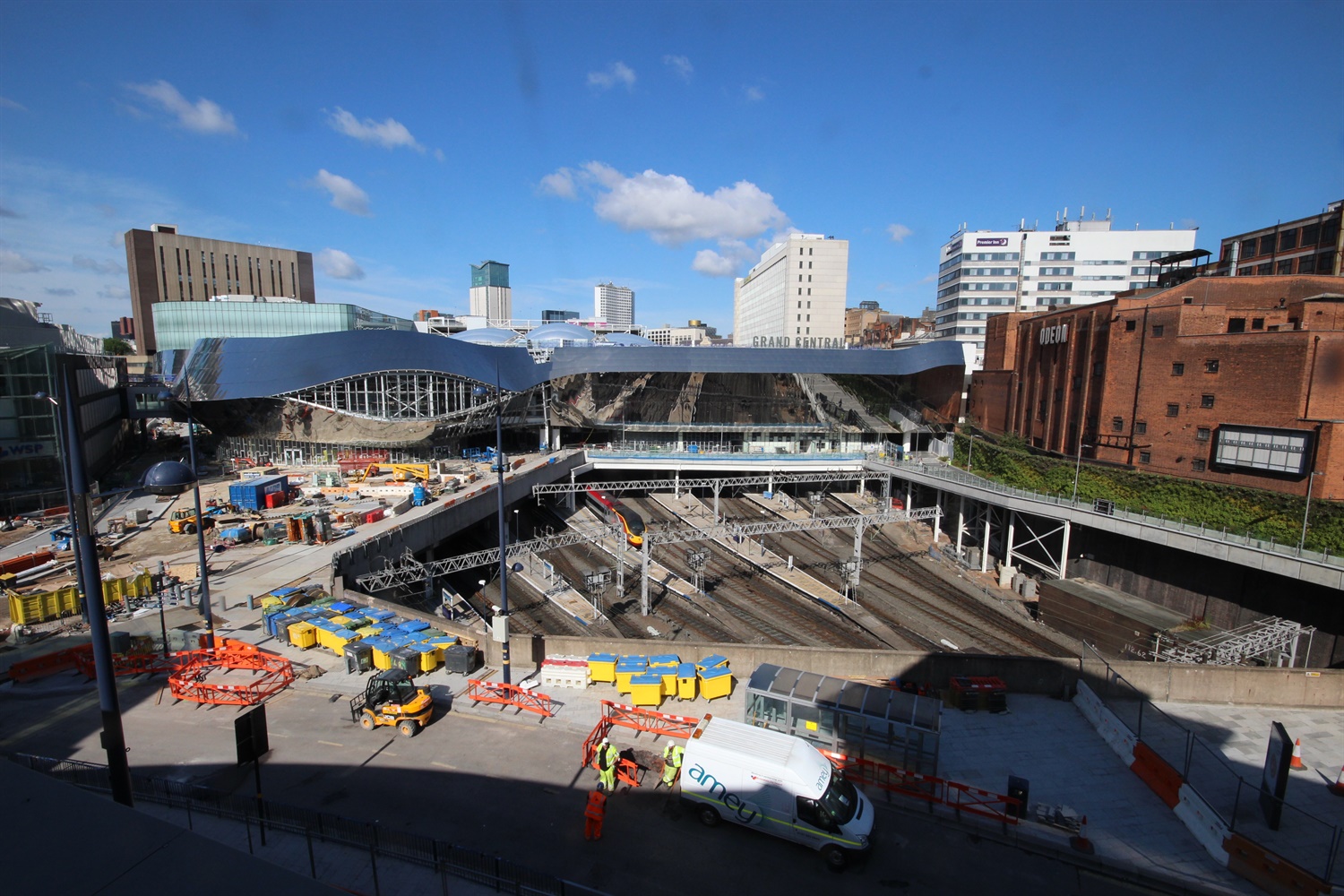01.08.15
A new dawn for New Street
Source: RTM Aug/Sep 15
 Chris Montgomery (pictured), Network Rail’s project director for the New Street project, talks to RTM’s David Stevenson about the final touches being made on the redevelopment of Birmingham’s main station and the programme’s impressive safety record.
Chris Montgomery (pictured), Network Rail’s project director for the New Street project, talks to RTM’s David Stevenson about the final touches being made on the redevelopment of Birmingham’s main station and the programme’s impressive safety record.
With just a few weeks to go until the revamped Birmingham New Street station officially opens to the public on Sunday 20 September, RTM was given an exclusive behind-the-scenes glimpse at what they can expect.
More than 3,000 operatives are on-site at the moment putting the final touches together on the build, which will deliver a much brighter, bigger and modern station to passengers.
There will be lifts and escalators linking all 12 refurbished platforms to the concourse level for the first time, significantly improving accessibility and passenger flows. However, work to finish upgrading the lighting and ceiling works on the platforms will carry on until October 2016.
A lot still to do
When RTM arrived at the station, used by 170,000 passengers a day (nearly treble the number it was designed for when it was last rebuilt in the 1960s), we were greeted by lots of hoardings and an army of orange-clad engineers.
Chris Montgomery, Network Rail’s project director for the New Street project, said: “We are just over four weeks away from opening. There is an awful lot of work to do in the next few weeks, but I am confident the team will be able to do it.”
Work is evidently underway in all corners of the station and when RTM was taken onto the site via the south side steps entrance, where the new ‘media eye’ has been undergoing colour testing, it felt like entering a concert venue or a stadium. We were taken through a small though not overly dark hoarding tunnel that led to the new bright and airy atrium, which allows natural light to stream down onto the concourse through its translucent roof.

The roof is made from ETFE – or ethylene tetrafluoroethylene – the same as that used at the Eden Project in Cornwall. It was completed in September last year, as reported in RTM’s October/November 2014 edition.
However, to create the atrium space beneath the bubble roof, a huge amount of demolition work had to be carried out in the months that followed.
“In the last six months we managed to complete the demolition, which was a brilliant piece of work. It was probably one of the most complicated pieces of demolition you could come across,” said Montgomery. “That really opened up the middle of the station and the atrium area. It is an awesome space. I went to a concert in Manchester, and when I came back through a corridor it felt like a similar atmosphere because it opens up and becomes all light – and the space hits you.”
RTM was told that the contractor Coleman & Company had originally estimated the demolition work would take a year to complete, but using Lean techniques and a bespoke machine – the ‘Mega Muncher’ – the team was able to reduce the estimate to six months.
“We actually finished it in five,” said Montgomery. “The ‘Mega Muncher’ made the demolition quicker. The powerful jaws meant you could crush the concrete into small pieces, which was then chuted to one side.”
The project’s city centre location made communication with the local neighbours, many of which are hotels, vital. “We removed about 8,000 tonnes and had to work around the clock on this critical path,” Montgomery said.
Fit-out
Inside the atrium, the teams are now putting together the final touches including painting the walls, installing ticket barriers, lighting, glass screens and installing arrival/departure boards.

Also, the internal skin of the atrium’s columns and bulkheads, which are covered with a combination of GRG and stretched fabrics, is mainly complete.
Montgomery said: “The reason we’ve used GRG is because, effectively, we have got a very rigid concrete structure with a thin steel structure on top of it. It uses bridge beam technology. So one end is a fixed beam and the other end is a guided moving bearing because the steel can expand and contract.
“Because of the shape, which includes a bit of twist, we had to use a material for the bulkheads that could twist (they can actually be moved by almost 25% off their axis without shattering), which is why we opted for GRG. The finish is really nice.” He added that the roof’s steel structure will be wrapped in a stretch fabric.
“We have to finish the fabric, all the flooring, painting and decorating and the small matter of fitting out all the retail units,” said Montgomery.

Grand Central
Overlooking the concourse is the Grand Central shopping complex, which will open on Thursday 24 September, after the openig of the station itself. The contractors for each of the retail tenants are also on-site.
“There are the guys in orange who are the rail workers and the retail fit-out contractors in yellow,” said Montgomery. “And there are about 2,000 of them at the moment, doing all the fit-outs within their units.”
Despite having so many workers in such a congested space, the New Street team has a very good safety record, and the project recently went over two million man-hours without a reportable accident.
Montgomery said that principal contractor Mace has led on a number of initiatives to make the project as safe as it is.
“It is probably more difficult for a contractor to work here than anywhere else because of the controls we have had to put in place,” said Montgomery. “I don’t think you can bring a drainage gang, for example, working on a railway embankment a few miles outside Birmingham and bring them into the station to do a bit of drainage and let them display the same behaviour and culture that they would out there. In the station they are working amongst the general public, train operators and staff, unionised train crews, all in very tight areas.
“We’ve got live safety systems, so one slip-up and they set off the fire alarm and the whole station gets evacuated. We have had to put in place – I call it changing the hearts and minds of the contractors – a lot of procedures and protocols that the contractors may find onerous but are necessary. And because of this a lot of the contractors have got much better because of it.”
Escalators
During the interview at Network Rail’s nearby Meridian House offices, Montgomery added that “issues” raised earlier this year with regards to the station’s escalators, installed at the end of phase 1 in 2013, have now been fixed.
RTM was told that there had been a “latent” issue with the chains. “The parent metal for the cog, which the chain was going through, wasn’t doing what it should be doing in terms of lubrication,” said Montgomery. He joked that the team became very good at fixing escalators.
Outside, the station is now mainly covered by a striking 16,000 square metre steel external façade, which includes three eye-shaped screens above the entrances.

However, there have also been further issues with the quality of the concrete. RTM was told that in order to not damage the integrity of the building, X-rays were taken before holes could be drilled to check for reinforcements before the façade panels could be fitted.
Once this delicate operation was complete, and the manufacturer created a base plate, the façade could be fitted and the team has been making “much progress”.
The total predicted cost for the New Street project is £750m, roughly £150m of which is for the building of John Lewis and Grand Central.
Project management
Discussing the project’s structure, Montgomery said: “You couldn’t build this job without collaboration. You could build this job by just having one main contractor, but then we wouldn’t have access to all the individual contractors. Because it is a refurb, and change is inevitable, I could have got a big contractor and given them a blank cheque saying ‘sort it out’.
“But we went down a construction management model where we directly employ 60 different contractors, and when you do it this way, collaboration has to be key.” He added that he was very happy with how work is progressing.
Looking ahead to next month’s opening, Montgomery said: “It is full steam ahead for 19 September, the last Saturday night shift, where all the tunnels and temporary arrangements are to be removed overnight. It will be a mammoth job. We have around 400 operatives working that night moving concrete blocks, tunnel units and cleaning right the way through until we open at 7.30 on the Sunday morning, which will be when the public finally get to see it.”